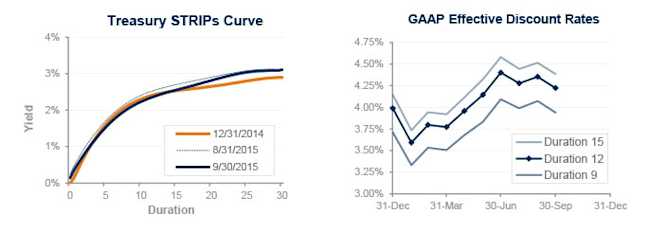September 2015 Pension Finance Update
September was a rough month for pension sponsors, capping a rough third quarter of 2015. Declining stock markets and lower interest rates hurt pension plans last month, eliminating gains from earlier this year for both model pension plans we track1. Plan A lost 4% during September and is now down almost 2% for the year, while Plan B dropped 2% last month and is now basically even for the year through September.

Assets
Stocks fell across the board for the second straight month in September: the S&P 500 lost more than 5%, the NASDAQ was down more than 2%, the small-cap Russell 2000 lost almost 8%, and the overseas EAFE index dropped more than 4%. Through three quarters of 2015, all flavors of stocks are in negative territory this year: the S&P 500 has lost 7%, NASDAQ is down more than 4%, the Russell 2000 is 9% lower, and the EAFE index has declined 5%.
A diversified stock portfolio lost more than 3% in September and 5% through the first three quarters of 2015.
Bonds gained 1% last month as interest rates edged down about 0.1%. For the year, a diversified bond portfolio is flat to up 1%, with short duration bonds and Treasuries performing best so far in 2015.
Overall, our traditional 60/40 portfolio lost almost 2% during August and is now down more than 2% for the year, while a conservative 20/80 portfolio was flat last month and remains down 1% for the year.
Liabilities
Both funding and accounting liabilities are now driven by market interest rates. The graph on the left compares Treasury STRIPs yields at December 31, 2014, and September 30, 2015, and also shows the movement in rates last month. The graph on the right shows our estimate of movements in effective GAAP discount rates for pension obligations of various duration during 2015 so far:

Interest rates fell about 0.1% during September and corporate bond yields are now about 0.25% higher than at the end of 2014 (Treasuries have risen about 0.10% this year, so credit spreads have increased 0.15% during 2015.) Last month’s move pushed pension liabilities up 2%-3% leaving them flat to down 1% compared with December 31, 2014, with long duration plans seeing the biggest decreases.
Summary
After topping out in June, pension sponsors have seen three straight months of declining pension funded status – driven be declining stock prices and interest rates – and are now modestly underwater through the first three quarters of 2015:

Looking Ahead
Due to 2014 pension funding relief legislation (HATFA), pension funding requirements over the next few years will not be appreciably affected by current low interest rates (unless these rates persist for several years). Required contributions for the next few years will be lower and more stable than under prior law, but higher pension funding requirements are likely for several years afterwards.
Discount rates moved down a bit last month. Most pension sponsors are using rates of 3.7%-4.4% to measure pension liabilities for accounting purposes in today’s environment.
The table below summarizes rates that plan sponsors are required to use for IRS funding purposes for 2015, along with estimates for 2016. Pre-HATFA, both 24-month averages and December ‘spot’ rates, which are still required for some calculations, such as PBGC premiums, are also included.

1 Plan A is a traditional plan (duration 12 at 5.5%) with a 60/40 asset allocation, while Plan B is a cash balance plan (duration 9 at 5.5%) with a 20/80 allocation with a greater emphasis on corporate and long-duration bonds. For both plans, we assume the plan is 100% funded at the beginning of the year and ignore benefit accruals, contributions, and benefit payments in order to isolate the financial performance of plan assets versus liabilities.
